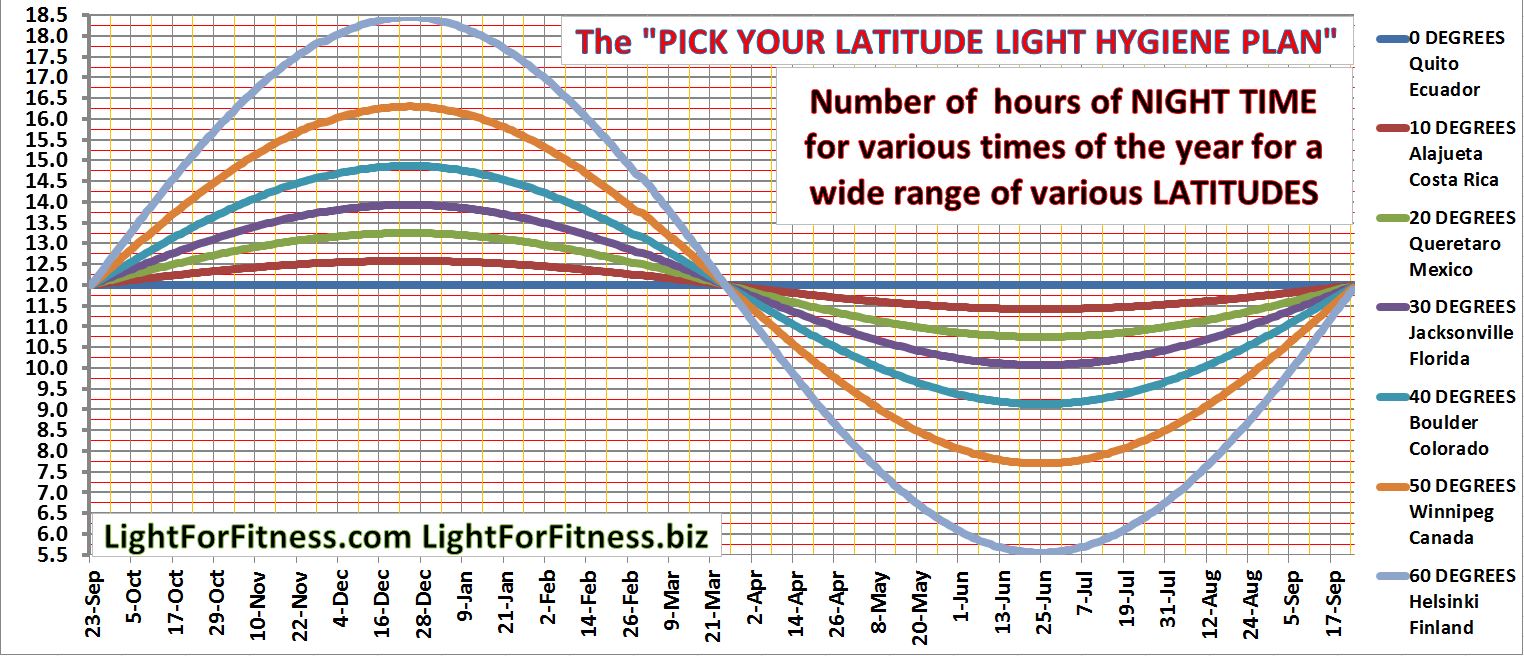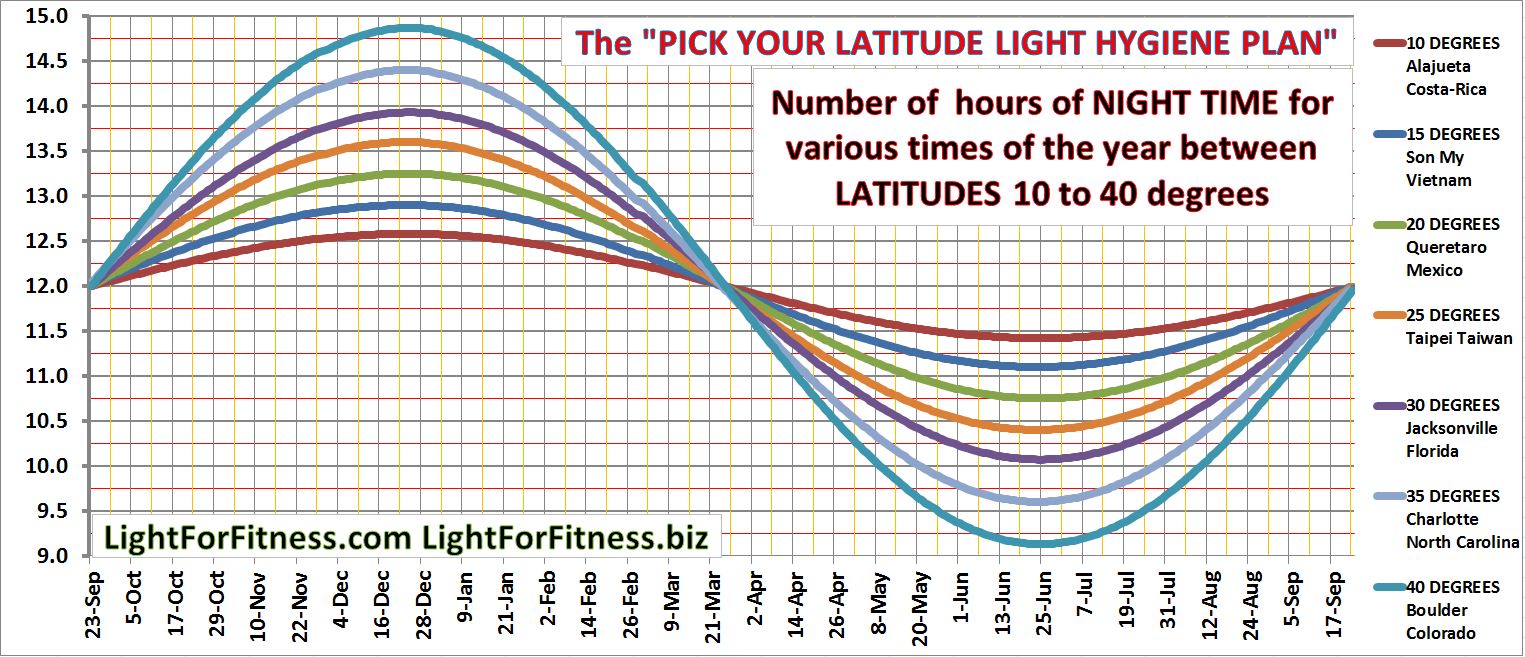MAIN MENU scroll down to read lower latitude plan
- ABOUT my transformation
- VIDEO TESTIMONIALS Light-Hygiene
- NEWS and EVENTS about Light For Fitness
- OUR EFFORTS toward Research
- BLOG Posts and Comments
- SCIENTIFIC PAPERS (Doubt? Read!)
- EXPLANATIONS OF TECHNICAL TERMS
- how to use – MELATONIN ONSET EYEWEAR – simple plan
- WHY?
- Why use our melatonin onset eyewear?
- Can I just turn off the BLUE PIXELS and skip wearing the orange glasses? NOPE!
- LINKS
- BUY! ENTER STORE FRONT DOOR LightForFitness.biz
how to use – MELATONIN ONSET EYEWEAR – simple plan scroll down to read lower latitude plan
Lower Latitude Plan
This is a plan for those who want more melatonin than the simple plan grants and less of the seasonal strain that is associated with the home-town plan. If a person is familiar with the home-town plan, this plan is exactly the same in implementation except you choose to follow the solar pattern of a lower latitude than the one you live in.
People who live in latitudes far from the equator might do well to move closer to the equator. However, moving isn’t always an option for everyone, and the light-hygiene benefits of latitudes closer to the equator can still be realized with a light-hygiene plan.
Below is an overview of a few places on the planet where people live. Note how severe the length of days and nights becomes as you move to latitudes farther and farther from the equator. Helsinki, Finland’s longest night is 18.5 hours long, as is their longest day. It would be a rare person who could tolerate in a healthy manner the winter and summer adaptations of such an extreme, thus the reason Europe has SAD support groups to deal with these issues.
(CLICK ON ANY GRAPHIC TO ENLARGE IT TO FILL THE SCREEN).
Persons who want to balance the advantages of deep seasonal adaptations against the possible health risks of such adaptations will likely be aiming to trade their light hygiene experiences to the lower latitudes of 40 degrees or less, thus the chart below.
(CLICK ON ANY GRAPHIC TO ENLARGE IT TO FILL THE SCREEN).
Say, for example, Alan presently lives at 43 degrees, but maybe he is noticing as he is aging that his blood sugar is getting too high in the summer months. The long days (15 hours) during the peak of summer signal his body to consume more carbohydrates. A younger and healthier Alan might power through this short time of carb craving/consuming excess, but the older Alan’s pancreas might be less inclined to make the insulin needed to cope with that kind of peak summer adaptation. Or, maybe his cellular mitochondria are lessening as he ages, and he just can’t use the calories his summer appetite calls for. For whatever reason, an aging Alan might one day might need to move either physically or at least “optically” closer to the equator.
Aged Alan is no longer the winter warrior or the summer soldier in his later years and finds himself more indoors and focused more on just surviving. He shields himself from the extremes of cold and heat by remaining indoors. He uses doors and walls and clothes instead of brown fat to keep him warm, or sweat to cool him; and only hikes outside during the moderate times of the year.
Although aged Alan still lives at 43 degrees latitude, he has decided that his eyes and brain need to be programmed to Jacksonville, Florida, at 30 degrees latitude. If he does this, his brain will be releasing melatonin during summer nights with a peak length of approximately 10 hours. Thus, his summer adaptation will be more shallow and his carb craving will be less severe than the 43 degree experience. His winter adaptation will also be very shallow.
By comparison, Jacksonville’s worst summer day is 1.5 hours short of the full 11.5 hours of melatonin the pineal gland can continuously provide, as opposed to Alan’s typical 2.5 hour worst summer day shortfall, that he presently experiences in his home-town at 43 degrees latitude.
To “transport” Alan’s eyes and brain to Jacksonville while his body still remains in New York State, he first needs to find a graph or chart or application online that will tell him the number of hours of darkness there will be on any given date at the latitude he has chosen. Other than this, he follows the exact same process as the home-town plan.
This link can help Alan on any day to know the number of hours of darkness nature would have provided for him in Jacksonville.
If today is Oct 29, nature will provide Alan approximately 13.1 hours of darkness (either using the graph above or the Daylight Hours Explorer) at 30 degrees latitude, Jacksonville. Since Alan’s alarm and lights will go on at 6 AM, from here he determines that he needs to start to wear his melatonin onset eyewear 13.1 hours earlier which would be at approximately 5 PM.
Since Alan lives at 43 degrees latitude and the aging lenses in his eyes are yellowing (natural yellowing of the lens with age reduces the light that hits the retina with each passing year), he may also need to use cortisol onset lighting, cortisol onset glasses, morning simulator or some kind of special lighting to get more light into his eyes before lunch time, especially during 43 degree latitude wintertime with its dark, long mornings.
Alan might be more prone to suffer from SAD, as he spends less time outdoors and exposes himself to less winter sunlight. He may need to intentionally supplement his morning light experiences.
Now you understand why and how to use the lower latitude plan.
Alan has met a new friend originally from Ecuador, named Jorge, and has a neighbor named Frank, who is now battling cancer. All three men now live at 43 degrees latitude. Click on the equator plan in the table of contents below to understand why and how the equator plan can help Jorge and Frank immediately and possibly, in the future, a very aged Alan.
how to use – MELATONIN ONSET EYEWEAR – simple plan scroll up to read lower latitude plan
MAIN MENU scroll up to read lower latitude plan
- ABOUT my transformation
- VIDEO TESTIMONIALS Light-Hygiene
- NEWS and EVENTS about Light For Fitness
- OUR EFFORTS toward Research
- BLOG Posts and Comments
- SCIENTIFIC PAPERS (Doubt? Read!)
- EXPLANATIONS OF TECHNICAL TERMS
- how to use – MELATONIN ONSET EYEWEAR – simple plan
- WHY?
- Why use our melatonin onset eyewear?
- Can I just turn off the BLUE PIXELS and skip wearing the orange glasses? NOPE!
- LINKS
- BUY! ENTER STORE FRONT DOOR LightForFitness.biz

